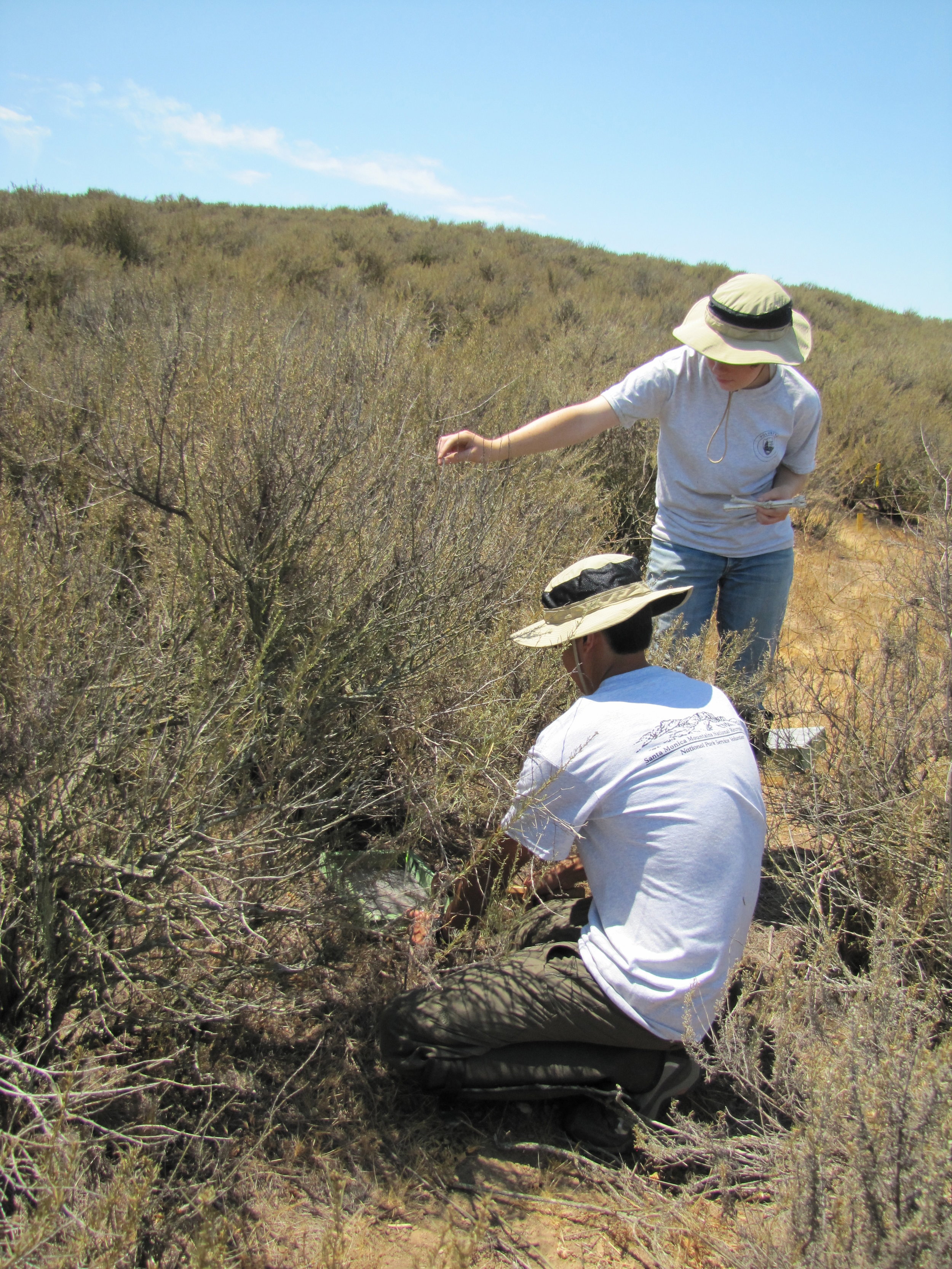Ecological Impacts of Nitrogen Deposition
A view of downtown Los Angeles from the Santa Monica Mountains. Note the iconic inversion layer of smog. High levels of atmospheric pollution have contributed to elevated nitrogen deposition, negatively impacting native ecosystems.
TOO MUCH OF A GOOD THING? In addition to global-warming greenhouse gases, air pollution from agriculture, industry, and transportation contains significant amounts of nitrogen (N). Eventually, this N in the atmosphere settles onto the earth's surface where it becomes available to plants. While N is an essential plant nutrient and more N might sound like a good thing, many ecosystems are actually adapted to low nutrient conditions. One of my major research goals is to understand how N deposition will impact California's native plant communities, such as coastal sage scrub.
Investigating ecological impacts of nitrogen deposition on coastal sage scrub of the Santa Monica Mountains
My dissertation research at the University of California, Riverside explored the ecological impacts of anthropogenic nitrogen (N) deposition on coastal sage scrub of the Santa Monica Mountains. Using a combination of observational field investigations, N fertilization experiments, and greenhouse studies, my results showed that N deposition may negatively impact this sensitive ecosystem in a number of ways. This work also highlights how N deposition may interact with other drivers of environmental change, such as drought and nonnative plant invasion, to the detriment of native plant species.
After five years of drought, native California sagebrush showed a dramatic decline, especially under high N deposition.
High N, dry: Nitrogen Deposition and Extreme Drought
From 2012 to 2016, California experienced an exceptionally severe drought due to below average rainfall and record-high temperatures. These "global change-type drought" events may become increasing common under projected climate change. Working with collaborators from the National Park Service, I investigated the impact of N deposition on coastal sage scrub of the Santa Monica Mountains during five years of drought. I showed that N deposition may worsen drought-induced shrub loss by increasing plant productivity and reducing water-use efficiency. While native shrubs declined, nonnative plant invasion increased over time, especially under high N.
This work provides strong evidence that N deposition can exacerbate the negative impacts of other drivers of global environmental change, including extreme drought and nonnative plant invasion. Together, these drivers may contribute to the conversion of native coastal sage scrub to invasive-dominated annual grasslands. Loss of native habitat will further impact native biodiversity and ecosystem services. This in turn could impact human health and property as well, since increased invasion of annual grasses is associated with elevated fire risk, potentially leading to bigger, hotter and more frequent wildfires. You can read more about this study in an article recently published in the journal Global Change Biology, found here.
Nitrogen Deposition and Post-fire Recovery of Coastal Sage Scrub
In May 2013, the Springs Fire burned a significant portion of the Santa Monica Mountains, including sites where my collaborators and I had installed N fertilization plots. While unplanned, this wildfire provided an ideal opportunity to explore the impacts of N deposition on post-fire recovery of native plant communities. Previous research has shown that N addition may slow post-fire succession of coastal sage scrub, but it is unclear at what level, or "critical load" of N addition that changes occur, or how universal this pattern is. I'm currently monitoring vegetation recovery in stands of coastal sage scrub at two sites in the Santa Monica Mountains. You can read more about the Springs Fire here. Standby for results from this ongoing experiment.
Field assistant Dwight Williams installs N fertilization plots in the burned landscape following the Springs Fire of 2013.
Declines in native plant richness with elevated nitrogen deposition were largely due to the loss of native forb species.
Increased Nitrogen Deposition Reduces Native Plant Diversity
Worldwide, a commonly observed consequence of N deposition is reduced plant diversity, however impacts on plant diversity of southern California's coastal sage scrub was previously unknown. Working with collaborators from the National Park Service, UC Riverside, and the U.S. Forest Service, I documented reductions in native plant diversity across the N deposition gradient of the Santa Monica Mountains. Sites closest to Los Angeles experienced the highest rates of deposition and exhibited the lowest plant diversity.






